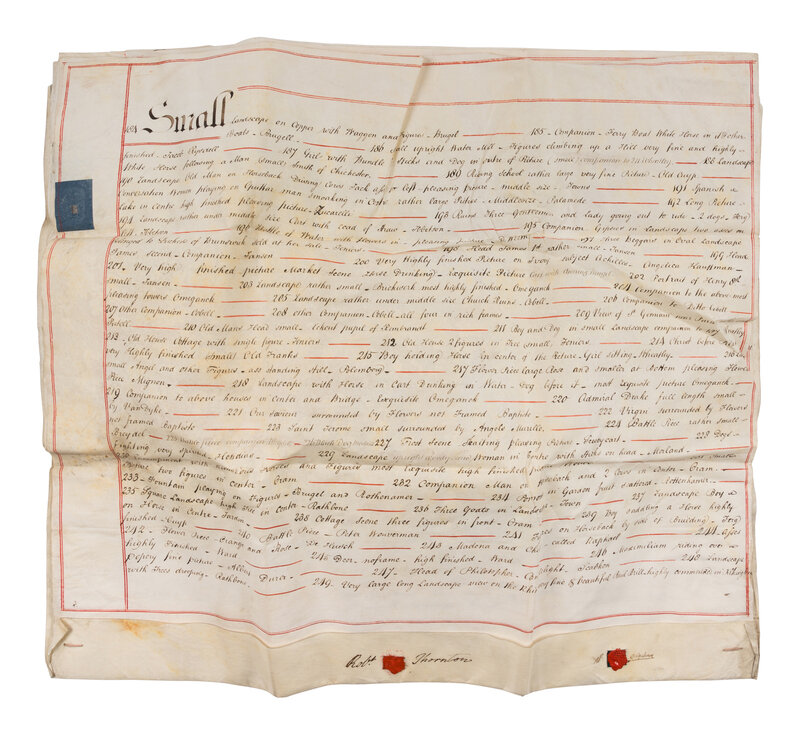THORNTON, Robert John. Two indentures regarding a grant of annuity secured against his art collection.
Sale 1336 - Fine Books and Manuscripts, including Worlds of Tomorrow, and Americana
Jun 7, 2024
9:00AM CT
Live / Chicago
Own a similar item?
Estimate
$800 -
1,200
Price Realized
$12,065
Sold prices are inclusive of Buyer’s Premium
Lot Description
THORNTON, Robert John (1768-1837). Two partially printed indentures signed ("Robt. Thornton") to Patrick Colquhoun ("P. Colquhoun"), regarding a grant of annuity secured against Thornton's art collection to resolve his debts, 30 June - 29 July 1814.
First document: 7pp. on vellum, 2 wax seals, tax stamps on each page, docketed on verso by conduit William Day, old folds.
Second document: 3pp. on vellum, wax seal, tax stamp, docketed on verso by conduit William Day, old folds.
A grant of annuity between Thornton, Colquhoun, and Grant David Yeats (1773-1836) regarding the security of Thornton's "valuable collection of pictures by esteemed Masters as specified and described in a certain catalogue of inventory thereof hereunder written..." The indenture lists over 300 artworks. Thornton would pay an annuity of 300 pounds to Colquhoun and Yeats in exchange for a lump sum of 6000 pounds. Colquhoun (1745-1820) was a Scottish magistrate, merchant, and founder of the first regular preventive police force in England, The Thames River Police. Yeats was an English-American physician and writer who authored the biography of Colquhoun in 1815.
[With:] Autograph letter signed ("Robt. Thornton"), to William Day, conduit, 27 June 1814. 3 pp., 8vo, old folds, two small tears on integral leaf from wax seal. Thornton requests that no delay be made of the payment against the security of his artwork that is to be deposited with Colquhoun or Yeats.
[With:] Autograph letter signed ("Wm. Day") to Patrick Colquhoun, 19 November 1814. 8vo, 1 page, on a bifolium, old folds. "I FEEL CONFIDENT THAT EVENTUALLY WE SHALL NOT BE LOSERS BY THIS UNFORTUNATE GENTLEMAN." Day mentions a letter he received from Thornton regarding his affairs that are being settled by his friends and await word from Colquhoun on further steps apparently to be rid of Thornton. Written on the verso and integral leaf of the bifolium are 2 pages of fair copies of two letters sent by Thornton to Day and Colquhoun.
Thornton is best known for his monumental work "The Temple of Flora," published in 1799 as part of a larger work titled "New illustration of the sexual system of Carolus von Linnaeus." "The Temple of Flora" is considered one of the most beautiful and extravagant botanical books ever produced, however, despite its artistic and botanical significance, the work was a commercial failure, and Thornton fell into significant debt as a result of its publication. The lavish production costs, coupled with Thornton's inability to sell enough copies, left him deeply in debt, and eventually led to his bankruptcy in 1813. Despite inheriting his family fortune, which the author used to fund his publication, Thornton was forced to sell his personal library and other possessions to pay off his debts. Thornton died in destitution.
Property from the Estate of Peter Fortsas
Condition Report
Auction Specialist



